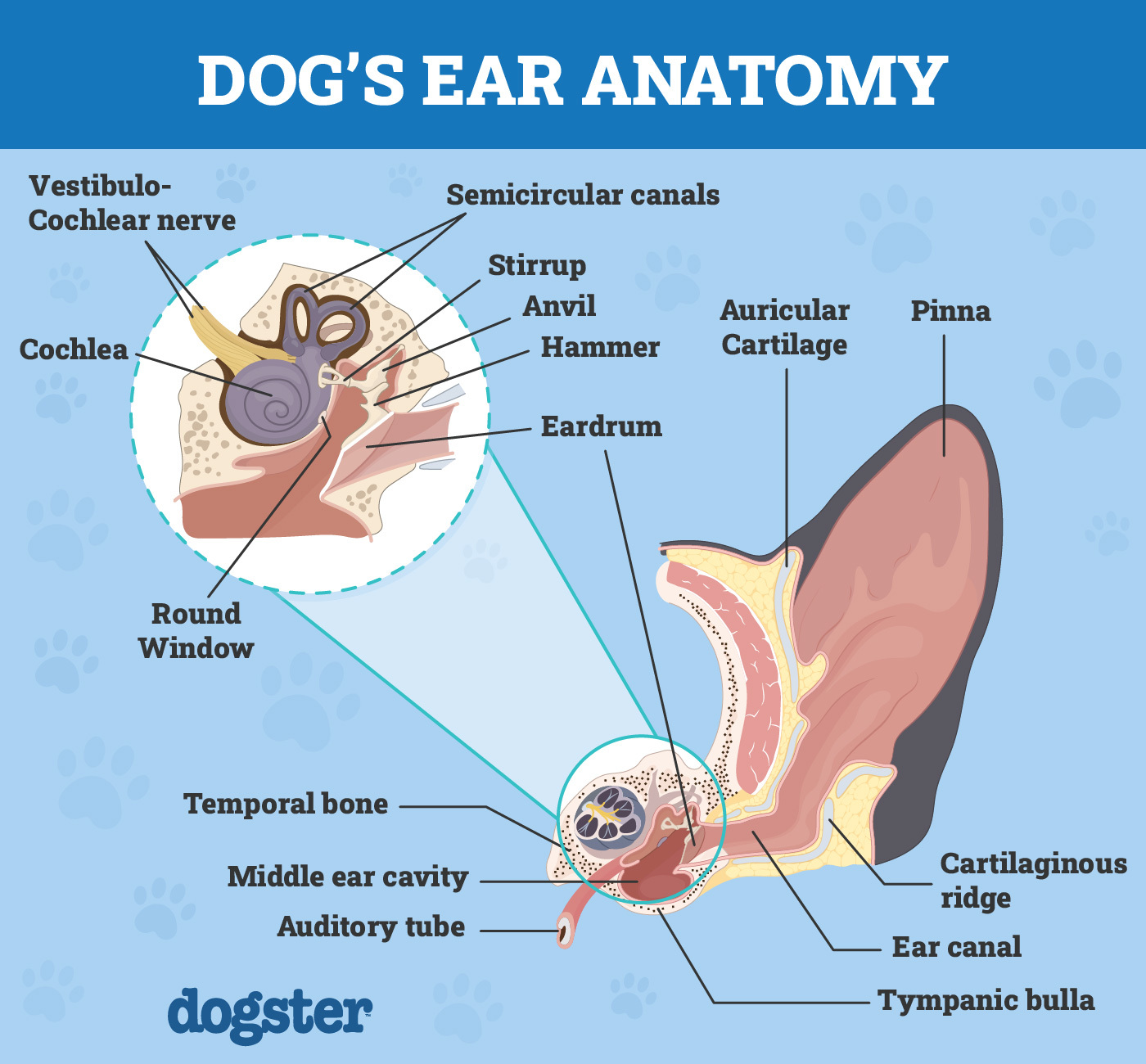Does your dog start barking at the door before the pizza guy rings the bell? Maybe they go bonkers right before the first thunderclap of a storm. And as any dog owner knows, it doesn’t matter how quietly you open a bag of chips—your dog will be at your feet before you take a single bite.
On average, dogs can hear sounds from 80 feet up to a mile away and even further under the right conditions. Their sense of hearing outstrips those of humans by at least four to five times. Frequency-wise, dogs can hear sounds many times higher,1 depending on the context.
However, a dog’s sense of hearing is more complicated than simply hearing sound from far away.
Keep reading to find out all the details about your dog’s incredible sense of hearing!

The Anatomy of a Dog’s Ear

Those cute, furry ears might look oh-so-squeezable, but they have a whole lot of complex anatomy behind them that makes your dog’s ears so special.
Canine ears have four basic parts:2
- Pinna: This is the exterior, movable flap of the ear. It’s what you’re thinking of when you think “dog ear”.
- External Auditory Meatus: This is the passageway that leads to the inner ear.
- Middle Ear: This chamber contains three small bones called ossicles, which are responsible for conducting sound vibrations to the inner ear.
- Internal (Inner) Ear: This is where the sound vibrations are converted into nerve impulses and sent to the brain.
Unlike human ears, dog ears have more than 18 muscles that give them superior mobility and allow them to rotate, tilt, flatten, and prick up. This allows the dog’s ear to capture sound waves from all directions—even those that are bouncing off nearby objects.
Their entire ear area also has a rich supply of nerves and blood vessels, which further enhance their hearing capabilities.
For Dogs, Hearing Equals Survival

Dogs descended from wolves, and they’ve kept many of their ancestral traits, including a powerful sense of hearing from their predatory heritage.
In the wild, staying alive meant being able to detect the faintest squeak of prey and predators alike, so having an acute sense of hearing was a major survival advantage.
Domesticated dogs may not need to rely on their exceptional hearing as much, but it’s still an important part of their lives. They use it to alert their pack (aka their family) to danger, connect with their humans, and make sense of the world around them.
What Frequencies Can Dogs Hear?

Ever wondered how those dog whistles work? Dogs can hear them, but most humans can’t.
To understand why, we need to discuss the concept of frequencies. Every sound has its frequency or pitch, which is measured in Hertz (Hz). The higher the Hz number, the higher the pitch. For instance, a high-pitched sound like a whistle has a higher frequency than a low-pitched sound like the rumble of thunder.
Humans can hear sounds in the range of 20Hz to 20,000Hz. But dogs? Their range is much wider. On average, they can hear frequencies as high as 45,000Hz—more than twice the range of humans!
This is why a dog can hear the shrill sound of a whistle that’s too high for humans to detect.
Combine that with how far dogs can hear, and you’ve got yourself a canine companion with what amounts to super hearing!
A Dog’s Sense of Sound vs Other Animals
While we’re no match for a dog’s sense of hearing, it’s not the most acute in the animal kingdom. In terms of frequency, certain animals can hear more than dogs—and the winner may surprise you:
| Animal | Average Frequency (Hz) |
| Goldfish | 3,000Hz |
| Dogs | 45,000Hz |
| Cats | 64,000Hz |
| Bats | 110,000Hz |
| Beluga Whales | 123,000Hz |
| Greater Wax Moth | 123,000Hz |
That’s right: the greater wax moth currently has the most sensitive hearing of any animal! While dogs may not take the crown, certain dog breeds can hear better than others.
Which Dog Breeds Can Hear the Best?

The shape and size of a dog’s ears can affect their hearing abilities.
For instance, breeds with long, droopy ears, like Cocker Spaniels and Basset Hounds, tend to have more difficulty hearing because their ears can block sound waves. Breeds with smaller, rounder ears, like Chihuahuas and Yorkies, on the other hand, tend to have better hearing due to their ears being more exposed.
Further, there are suggestions that some breeds, such as German Shepherds, Greyhounds, and Beagles, have particularly acute senses of hearing, thanks to their ancestry as hunters and trackers.

Can Dogs Hear Through Walls?
Depending on the wall’s structure, they typically can! The denser the material (e.g., concrete or brick), the fewer sound waves can penetrate, but if there is an open space between walls, dogs can easily pick up what’s happening on the other side.
Do Dogs Have ESP?
It certainly seems like they do; dogs have been known to sense earthquakes and other disasters moments before they happen. They can also sense when their owners are feeling down and come over to give them a comforting nuzzle or two.
For now, there’s no scientific evidence to back this up, but the explanation may be simpler than we think.
For example, earthquakes are preceded by changes in the environment that dogs are thought to sense through a combination of their heightened smell, hearing, and sight. As for sensing emotions, dogs are incredibly empathetic and in tune with their owners, so it’s not hard to imagine that they can pick up on subtle behavior cues.

Conclusion
All in all, dogs have an amazing sense of hearing that far surpasses our own. Whether it’s using their ears to pick up on subtle environmental changes or being able to detect a high-pitched whistle that’s inaudible to humans, dogs are truly remarkable creatures when it comes to their hearing.
So, the next time your pup perks up its ears and looks around, take a moment to appreciate how truly incredible its sense of hearing is!
Featured Image Credit: Capri23auto, Pixabay



















